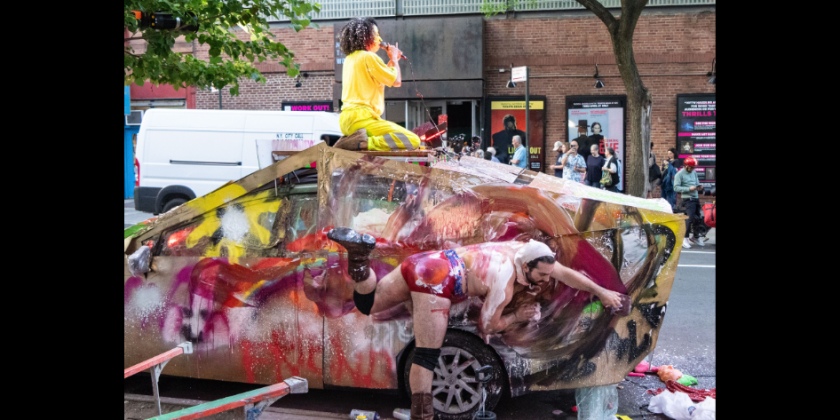IMPRESSIONS: Ballet Hispánico’s Star Rises at New York City Center

Artistic Director and CEO: Eduardo Vilaro
Founder: Tina Ramírez
Artistic Associate and Rehearsal Director: Johan Rivera
Choreographers: William Forsythe, Annabelle López Ochoa, Michelle Manzanales, Omar Román de Jesús, and Pedro Ruíz
Dancers: Fátima Andere, Leonardo Brito, Amir Baldwin, Antonio Cangiano, Ana Estrada, Amanda del Valle, Paulo Hernández-Farella, Cori Lewis, Dylan Días McIntyre, Hugo Pisano Orozco, Omar Rivera, Isabel Robles, Gabrielle Sprauve, Isabella Vergara
Ballet Hispánico’s recent appearances at New York City Center from June 1-3 turned the spotlight on a company whose star is rising. During this brief engagement, the troupe demonstrated versatility and ambition with engaging premieres by two contemporary dancemakers and an eye-popping neo-classical pas de deux. Honoring Ballet Hispánico’s roots, each program wound up with an explosive ballroom number thrilling those of us who are always ready to rumba.

The duet from William Forsythe’s New Sleep recalled the choreographer’s heyday in the 1980s, when he was shaking up the ballet establishment with funhouse distortions of the dancers’ classical line. Those who believed George Balanchine had pushed ballet to its limits were forced to think again. In New Sleep, dancers Fátima Andere and Antonio Cangiano are alternately loose and taut, over-stretched and off-kilter, with Andere’s extended leg swinging around dangerously. Forsythe coyly marks the rhythm with repetitive moves, and the duet ends with Andere and Cangiano rocking side-to-side like pendulums on a pair of metronomes, their bodies crossing. The dancing is playful, but Thom Willems’ industrial score painfully assaults the listener.

Papagayos, a new work by Omar Román de Jesús, begins deceptively, introducing us to Amanda del Valle, a childlike character in a gaudy, tinseled costume, who banters with the audience before the curtain rises. The atmosphere of innocence dissipates quickly, however, once we get inside the dance.

Here Amir Baldwin lords it over the players in a deadly game of musical chairs, shooting the odd-man-out. The number of contestants never seems to decrease, however. There is no exit from the gloom in Papagayos (think Jean-Paul Sartre's Huis Clos), though someone attempts to crawl away beneath the row of chairs, and couples on the sidelines kiss and make out. When Baldwin isn’t murdering people, he makes them bounce or collapse, wielding his power capriciously.

Hugo Pisano Orozco plunges into an evasive, staggering solo, and two duets emerge: Baldwin dances with Cori Lewis, who appears dead or unconscious, while Gabrielle Sprauve and Omar Rivera find a rhythm and work it, both of them vigorously alive. He rubs his hands together eagerly, and makes her fly. She looks dazed, but as Rivera leads her into the wings Sprauve waves her hand flirtatiously. These people know how to party, even in a hellscape.
As this tragi-comedy unfolds, it appears that the power belongs to whoever wears Baldwin’s hat. When Del Valle has it, the executions continue with a perverse twist, and like any tin-pot dictator she enjoys watching the company shuffle in a Zombie prison march. Yes, this is our world, and it will only improve when, like Pisano Orozco, at the end of Papagayos, we are able to refuse the urge to command.

In Sor Juana, this season’s second premiere, choreographer Michelle Manzanales evokes a genius of Spain’s Golden Age, the Mexican poet and philosopher Sor Juana Inés de la Cruz. Now a feminist icon, the 17th-century poet entered a convent so she could devote her life to scholarship — an occupation from which women were excluded in her day. Manzanales first places Sor Juana amid the pomp of the Viceregal court, where, as the title character, Gabrielle Sprauve’s erect bearing and spare gestures set her apart from her contemporaries. All around her, individuals swoon and appear stricken, crumpling under the influence of Baroque passions. Sor Juana has a private itch, however. Pawing and scratching, she eventually discovers a vein of inspiration from which sprout curling hand gestures — the ornate verses that she composed in the style of Góngora.

Lest anyone imagine that Sor Juana’s heart was cloistered, we hear one of her poems recited, in which the poet responds to a jealous lover’s suspicions by distilling her heart in tears. Manzanales accompanies this text with a gentle duet for Sprauve and Isabel Robles, who tiptoe around each other, meet back-to-back, and then strip. Sprauve carries Robles outspread in ecstasy, and they nuzzle against each other on the floor. Yet they also dodge a kiss, making this relationship as ambiguous as the real Sor Juana’s biography. In addition to the poem, the composite score includes snatches of Baroque guitar music, cantatas, and atmospheric effects like the scratch of a quill pen on parchment.

Fast forward to the 1950s, in Havana, where Sor Juana, I mean Gabrielle Sprauve, has become a slinky sexpot slowly exhaling cigar smoke as Omar Rivera supports her in a deep backbend. Sprauve appears to be everywhere this season, but in Club Havana her endless legs and dramatic presence make her a standout.
The ballet recalls an era of bygone elegance, on a sultry night when the rhythms of the dance awaken desire. Pedro Ruíz’s choreography is delicate and exuberant by turns, and Club Havana’s irresistible score by the likes of Pérez Prado and Francisco Repilado is a Cuban hit-parade.













